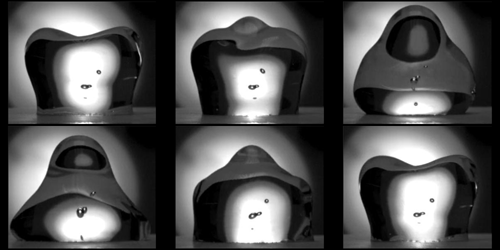Water Droplets Shape-Shift on the ISS
A droplet of oil on a Teflon pan quickly spreads to wet the surface. A droplet of water spreads much more slowly, if at all. But for a liquid droplet sitting on a vibrating solid substrate, a third, less-common option is predicted: the droplet’s outer edge—its contact line—can move back-and-forth freely across the surface. To uncover how different parameters affect those dynamics, Josh McCraney at Cornell University and his colleagues investigated contact-line motion without the droplet-squashing effect of gravity [1]. Their experiments, carried out on the International Space Station (ISS), show how free-moving contact lines correspond to oscillations in droplet shape—a finding that could improve industrial processes on Earth.
To probe how a liquid droplet behaves without gravity, researchers on the ISS used a syringe to deposit 10-mL water droplets onto hydrophobic surfaces of varied roughness. Then they set the surface vibrating up and down at a gradually increasing frequency while they filmed the droplet from the side. As a proxy for the free movement of the droplet’s contact line across the surface, the researchers identified points in the cycle at which the droplet, driven by the oscillation, wobbled between pancake-like and more spherical shapes. Comparing these measurements to a theory that relates the droplet’s resonant frequency to inertial and capillary forces acting on it, the researchers confirmed a model that predicts the contact-line motion in terms of the liquid’s density and surface tension.
The researchers say that the ISS-based evidence could help to predict inertial droplet-spreading behaviors on Earth as advances in fabrication processes further reduce the scale of surface defects. Such information could be useful in applications including additive manufacturing, spray cooling, and fuel management.
–Rachel Berkowitz
Rachel Berkowitz is a Corresponding Editor for Physics Magazine based in Vancouver, Canada.
References
- J. McCraney et al., “Oscillations of drops with mobile contact lines on the International Space Station: Elucidation of terrestrial inertial droplet spreading,” Phys. Rev. Lett. 129, 084501 (2022).




